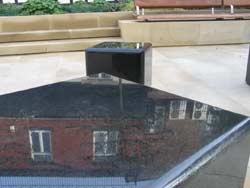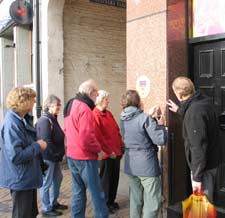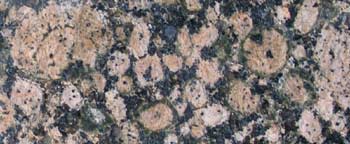| |
The Building Stones of Wakefield |

 WHEN
YOU LOOK closely at these blocks of gabbro (left) in
Tammy Hall Street in the centre of Wakefield, you see dark
crystals but when you photograph them it’s
the reflections of the buildings beyond that are most noticeable. It’s
probably to do with the way the eye focuses on surface detail while your brain
filters
out ‘superfluous’ distractions, such as the reflections.
WHEN
YOU LOOK closely at these blocks of gabbro (left) in
Tammy Hall Street in the centre of Wakefield, you see dark
crystals but when you photograph them it’s
the reflections of the buildings beyond that are most noticeable. It’s
probably to do with the way the eye focuses on surface detail while your brain
filters
out ‘superfluous’ distractions, such as the reflections.
Gabbro contains black ferro-magnesian rich minerals, known as
'mafics'.
The gabbro and the
grey granite and micro-granite setts (cobbles) nearby are new additions
to the building stones of the city. The old local sandstone setts that were
taken
up during the refurbishment have been used to fill the gaps in an adjoining
cobbled
alley,
the George
and Crown
Yard.
Granites
 At
the top of Westgate (top, right), you can see
a variety of granites,
including one (left) that was probably quarried in Finland, which
contains reddish crystals of feldspar.
At
the top of Westgate (top, right), you can see
a variety of granites,
including one (left) that was probably quarried in Finland, which
contains reddish crystals of feldspar.

 Granite
formed from molten rock at the roots of mountains during continental collisions.
In Rapakivi
Granite (above), also from Finland, the feldspars
have been partially remelted, losing their angular shape, like an ice-cube
dipped in water, and have subsequently
acquired a rim of greenish plagioclase feldspar.
Granite
formed from molten rock at the roots of mountains during continental collisions.
In Rapakivi
Granite (above), also from Finland, the feldspars
have been partially remelted, losing their angular shape, like an ice-cube
dipped in water, and have subsequently
acquired a rim of greenish plagioclase feldspar.
Rapakivi granite has been
dated at over 1,500 million years old, which is ten times as long
ago as the heyday of the dinosaurs and 900 million years before complex
life first appeared
in the
fossil record. That makes the shop front of the Southern Chicken takeaway
on Westgate the most ancient thing in the city of Wakefield! (unless someone
happens
to have a chunk of a meteorite, which formed about 4,500 million years ago).
Jurassic Shell Beds
The
frontage of the Midland Bank (right) is built
of Portland
Stone,
an oolitic limestone which contains drifts of the shells of bivalves - clams
and oysters - of the Jurassic period. Oolitic refers to the texture, which
resembles
fish roe. As lime accumulated in a tropical sea, it was rolled around by
the current; a process that can be observed in parts of the Caribbean today.
Portland
Stone
is quarried
at Portland Bill in
Dorset. It was shipped to London for the reconstruction of the city after the
Great Fire of 1666.
A public house by Kirkgate railway station, at the other side
of town, was the first building to be constructed of Portland
Cement, which was invented in 1824 by Joseph Aspdin (1778-1855)
as an alternative to Portland Stone. Aspdin is buried in St John's
churchyard,
Wakefield.
The Westgate Run
The Portland Cement pub is unfortunately boarded up at present,
like so many local pubs, but, against the trend, the dozens of pubs and wine
bars (someone estimated that there are about 40 of them!) on Westgate seem
to be thriving, partly as a result of 'the Westgate Run',which starts at the
Redoubt at the lower end of the street. This pub crawl was recently made infamous by the anti-social behaviour
of the city's Trinity Wildcats rugby league who were out in drag, which must
have been quite a sight in itself, celebrating the end of the season. 'Wildcats
Night of Shame' was the headline in the local paper.

 WHEN
YOU LOOK closely at these blocks of gabbro (left) in
Tammy Hall Street in the centre of Wakefield, you see dark
crystals but when you photograph them it’s
the reflections of the buildings beyond that are most noticeable. It’s
probably to do with the way the eye focuses on surface detail while your brain
filters
out ‘superfluous’ distractions, such as the reflections.
WHEN
YOU LOOK closely at these blocks of gabbro (left) in
Tammy Hall Street in the centre of Wakefield, you see dark
crystals but when you photograph them it’s
the reflections of the buildings beyond that are most noticeable. It’s
probably to do with the way the eye focuses on surface detail while your brain
filters
out ‘superfluous’ distractions, such as the reflections. At
the top of Westgate (top, right), you can see
a variety of granites,
including one (left) that was probably quarried in Finland, which
contains reddish crystals of feldspar.
At
the top of Westgate (top, right), you can see
a variety of granites,
including one (left) that was probably quarried in Finland, which
contains reddish crystals of feldspar.
 Granite
formed from molten rock at the roots of mountains during continental collisions.
In Rapakivi
Granite (above), also from Finland, the feldspars
have been partially remelted, losing their angular shape, like an ice-cube
dipped in water, and have subsequently
acquired a rim of greenish plagioclase feldspar.
Granite
formed from molten rock at the roots of mountains during continental collisions.
In Rapakivi
Granite (above), also from Finland, the feldspars
have been partially remelted, losing their angular shape, like an ice-cube
dipped in water, and have subsequently
acquired a rim of greenish plagioclase feldspar.